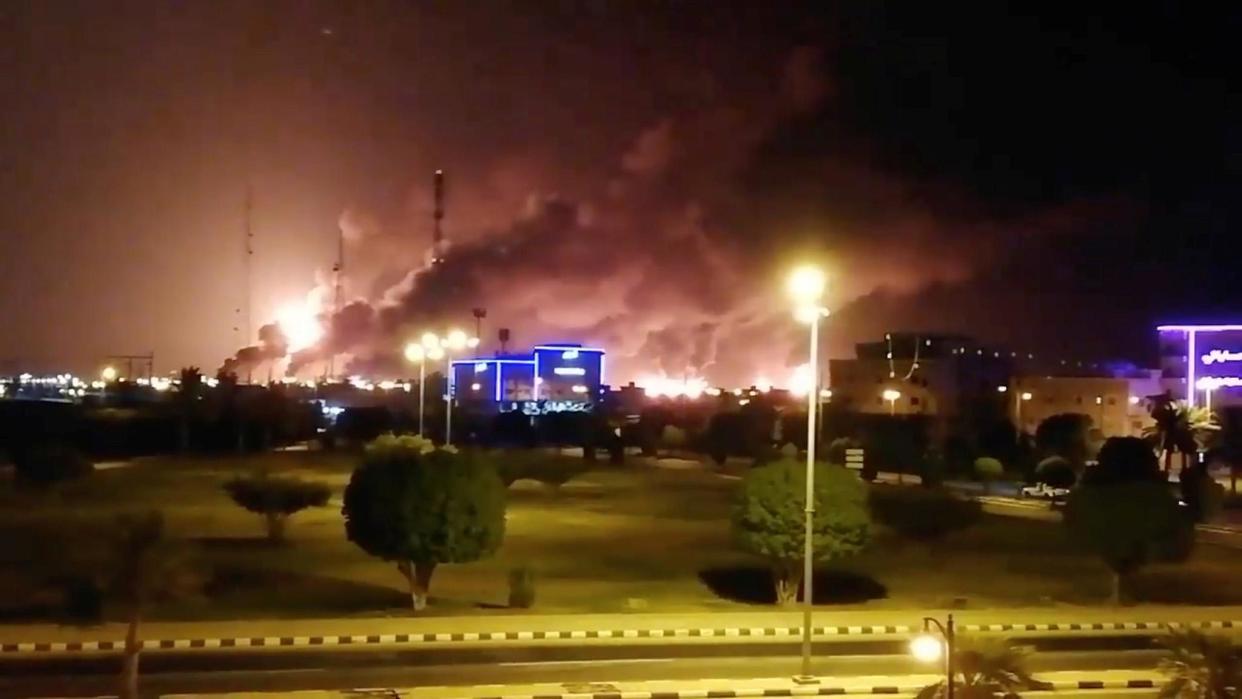Trump’s tough talk on Iran is just bluster – and Iran’s Revolutionary Guards are running rings round him

Mr Fire and Fury is back – and this time, he says, he’s locked and loaded.
On Sunday, Donald Trump used his favourite pulpit, Twitter, to respond to the previous day’s drone and missile attacks on two Saudi oil installations, more than halving the kingdom’s production. His words implied that whoever was responsible might soon have hell to pay, and with his own secretary of state singling out Iran for the attacks, it was clear who Trump was referring to.
Of course, while the former star of The Apprentice has often chest-thumped that he’s ready for a missile version of his old show, he tends to hold fire.
In late June, Trump said he had got to the point of ordering US airstrikes on targets inside Iran in retaliation for the country’s Revolutionary Guards downing an American drone near the Strait of Hormuz. But within an hour he called the operation off, and within days he reverted to what’s most likely his primary objective: an unprecedented on-camera handshake with Iranian president Hassan Rouhani, adding to the list of unlikely meetings he began with North Korea’s Kim Jong-un.
This handshake, however, has yet to happen. The problem for The Donald is that any Iranian official shows up to a diplomatic meeting only with the permission of the Islamic Republic’s supreme leader. And Ayatollah Khamenei will not budge until the US withdraws the comprehensive sanctions it imposed last November, six months after Trump tore up the 2015 nuclear deal between Iran and the 5+1 powers.
Saudi Arabia oil supply was attacked. There is reason to believe that we know the culprit, are locked and loaded depending on verification, but are waiting to hear from the Kingdom as to who they believe was the cause of this attack, and under what terms we would proceed!
— Donald J. Trump (@realDonaldTrump)
So with the current impasse locked in place, which way are the winds blowing in the Persian Gulf?
The answer doesn’t lie with the two opposing governments, but with Iran’s own specialist military forces, the Revolutionary Guards, who are already pursuing their own campaign.Since last year, the challenge for the Iranian government has been how to regain the initiative from the Trump administration’s strategy of “maximum pressure”, designed to subject the Islamic republic’s economy to intolerable pain.
President Rouhani and his foreign minister, Javad Zarif, are trying to forge and protect vital economic links with other countries, especially in Europe, but their efforts have so far been fruitless. Meanwhile, the supreme leader has ruled out any direct diplomatic engagement with the Americans, and has rebuffed European calls for negotiations over his country’s nuclear programme or its activities in the Middle East, such as its support of Syria’s Bashar al-Assad.
That leaves open the possibility of a quasi-military counter-offensive by the guards, targeting both the Americans and the “weak” Rouhani government itself. Inside Iran, the guards have stepped up their seizures of dual and foreign nationals, including from the US, UK and Australia, while using domestic media outlets to jab at Rouhani and Zarif. They have not only downed an American drone but also apparently attacked tankers in UAE ports and the Persian Gulf.
http://players.brightcove.net/624246174001/default_default/index.html?videoId=5837728067001
Support free-thinking journalism and attend Independent events
On 19 July, the guards seized the UK-flagged tanker Stena Impero, acting on the supreme leader’s command for retaliation after the Iranian supertanker Adrian Darya 1 was impounded in Gibraltar. (The Adrian Darya was released last month after Iran guaranteed it the ship would not deliver oil to the Assad regime. That guarantee was shortly broken, while Stena Impero is still held in the southern Iranian port of Bandar Abbas.)
Officially, Saturday’s attacks were the work of the Houthi insurgents who control much of Yemen, and who have claimed responsibility. Unofficially, the Revolutionary Guards have trained and supplied the Houthis through their series of strikes against Saudi targets this year. And now the US is claiming that the latest attacks, as well as some of the earlier ones, came from not from Yemen but from Iranian-backed forces in Iraq.
Of course, both the Iranian regime and those reflexively suspicious of any US government will note that there is still no conclusive proof of Tehran’s complicity in this latest incident. They will question anyone who accuses Iran of perpetrating the tanker attacks in the Strait of Hormuz, putting pressure on the route for a fifth of the world’s oil supply.
Read more
The world is a mess of fragile tyrants, so Israel can plunder at will
Unprecedented attack on Saudi oil brings Middle East to the brink
But in a shrewd response to US pressure and Iranian counter-pressure, the Revolutionary Guards are openly taking the lead in Tehran’s response to the Trump strategy, as the Islamic republic tries to avert catastrophic economic crisis. As General Ali Hajizadeh, the guards’ air force commander, made clear on Sunday: “In addition to US bases in the region, we have all their vessels, including aircraft carriers and warships, under fire of our missiles to a radius of 2,000km, and are constantly monitoring them.”
At the very least, the guards have sunk Trump’s ambition for an on-camera handshake with an Iranian VIP, which he might have pursued later this month at the UN general assembly. The far more important issue now is what other casualties should be expected, from further death and destruction in the Middle East to the choking of the world’s oil supply.
To go by Trump’s tweets, more fire and fury is on the way. But the Revolutionary Guards are already on the march, and there is little no precedent for Trump acting on his words. To paraphrase Joseph Stalin’s quote about the Pope: “How many divisions does a Twitter account have?”

 Yahoo News
Yahoo News 
